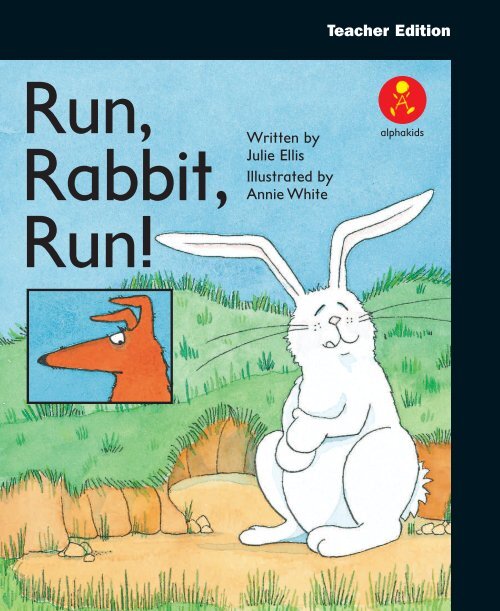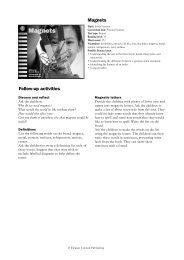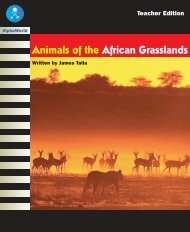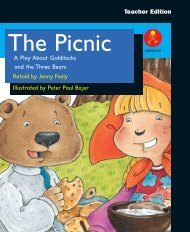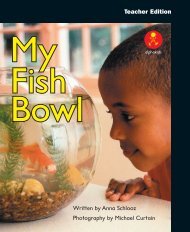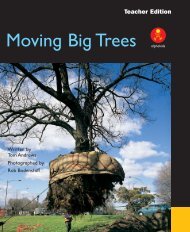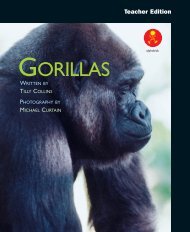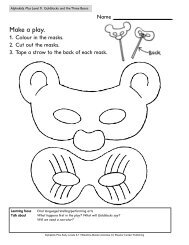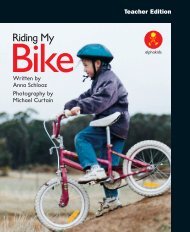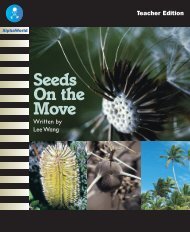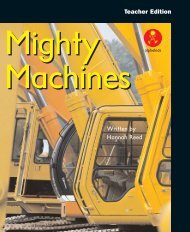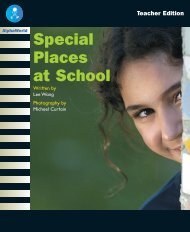Run, Rabbit, Run
Run, Rabbit, Run
Run, Rabbit, Run
You also want an ePaper? Increase the reach of your titles
YUMPU automatically turns print PDFs into web optimized ePapers that Google loves.
Teacher Edition<strong>Run</strong>,<strong>Rabbit</strong>,<strong>Run</strong>!Written byJulie EllisIllustrated byAnnie Whitealphakids
Published edition© Eleanor CurtainPublishing 2004First published 2004Apart from any fair dealing forthe purposes of study, research,criticism or review, aspermitted under the CopyrightAct of Australia, no part of thisbook may be reproduced byany process, or transmitted inany form, without permissionof the copyright owner. Wherecopies of part or the whole ofthis book are made under PartVB of the Copyright Act, thelaw requires that records ofsuch copying be kept and thecopyright owner is entitled toclaim payment.Developed byEleanor Curtain PublishingText: Elizabeth GoldingConsultant: Susan HillDesigned byAlexander StittProduction byPublishing SolutionsPrinted in ChinaISBN 0 7253 3387 11 2 3 4 5 6 7 8 904 05 06?How to use this bookBefore reading: TalkthroughTalk through the book with the children. Encouragethem to predict the text from the cover and thepictures, and to think about the information theyprovide. Direct the children’s attention to aspects ofthe text that may challenge them. Support the childrento deal with these challenges by asking theTalkthrough questions on each page.During reading: Observe and supportObserve the children as they read. Encourage themto monitor their own reading as they comprehendthe text. As needed, support the children by helpingthem to discover and use reading strategies and cuesto solve problems and respond to reading challengesthat arise in the text. Interruptions to the children’sreading should be minimal and focused on specifiedlearning needs.After reading: Comprehension, returning tothe text, responding and writing linksTo further develop children’s understanding of thetext, select from activities found on page 16 and theinside back cover. These whole text, sentence and wordlevel activities reinforce the teaching focus of thisbook. Assessment ideas are provided to assist withplanning for further teaching.Text highlights• The text features directional language:through, along, under, past, around.• Colour illustrations support the text.• The illustrations carry a subplot.Vocabularyalong, around, clothes line, fence, grass,hopped, house, past, path, through, under,wheelbarrow
Setting the contextPrepare cards with the words ‘through’,‘along’, ‘under’, ‘past’ and ‘around’ on them.Ask the children to move as directed by thecards. For example: Hold up ‘past’ and askthem to walk past the chair.Introducing the bookIn this book, a rabbit runs all the way fromhis hole to the carrot patch. He doesn’tknow that a dog is trying to catch him.Front coverRead the title to the children and point outthe names of the author and illustrator.Why do you think the rabbit will have to run?Title pageLook at the picture of the rabbit.Where might he be running to?
<strong>Run</strong>, <strong>Rabbit</strong>, <strong>Run</strong>! Pages 2–3?TalkthroughWhat animals can you see? The rabbit is holding his tummyand licking his lips. What do you think that means?Observe and supportDo the children understand the literal meaning of thetext? Can they also gain meaning from the illustrationsand use this information to make sensible predictions?Where has the rabbit just come from? What does the rabbitsay? What do you predict will happen next?2
<strong>Run</strong>, <strong>Rabbit</strong>, <strong>Run</strong>! Pages 4–5?TalkthroughWhat is happening in this picture? Where is the rabbit going?Is it easy for a rabbit to hop through grass?Observe and supportDo the children notice when they have made a mistake?Do they correct it?I like the way you fixed that up. How did you know it waswrong?I didn’t understand that sentence. Could you read it again?4
<strong>Run</strong>, <strong>Rabbit</strong>, <strong>Run</strong>! Pages 6–7?TalkthroughWhere is the rabbit hopping now? Yes, along the path.Observe and supportAre the children able to interpret the informationprovided by the illustrations?Does the rabbit know that the dog is chasing him? Why doyou think this? Why might the dog be chasing the rabbit?6
<strong>Run</strong>, <strong>Rabbit</strong>, <strong>Run</strong>! Pages 8–9?TalkthroughWhere has the rabbit hopped to now? Who is sneaking underthe clothes line? Do you think the rabbit knows the dog isfollowing him?Observe and supportCan the children use visual literacy skills to recognisethat the illustrations carry a subplot?What do the pictures tell you about the dog?8
<strong>Run</strong>, <strong>Rabbit</strong>, <strong>Run</strong>! Pages 10–11?TalkthroughWhat has the rabbit hopped past? Where do you think therabbit is going? What do you think the dog is trying to do?Observe and supportCan the children use their knowledge of letter-soundrelationships to help with decoding?Look at the first letter. What sound does it make? What wordstarting with the /h/ sound would make sense here? Doesthe picture support this?10
<strong>Run</strong>, <strong>Rabbit</strong>, <strong>Run</strong>! Pages 12–13?TalkthroughWhat is the dog hiding in? Where did the rabbit hop? Yes,that’s right, around the wheelbarrow.Observe and supportCan the children use information in the text and theillustrations to read new vocabulary?I saw you looking at the picture. How did it help you? Whatelse helped you?Look at the picture. What does it tell us about where therabbit went? Look at the text. What words do you alreadyknow?12
<strong>Run</strong>, <strong>Rabbit</strong>, <strong>Run</strong>! Pages 14–15?TalkthroughWhere has the rabbit gone now? Do you think the dog will behappy with this? Why?Observe and supportCan the children read with expression to build thetension in a story?Can you read that again to make it sound exciting?14
<strong>Run</strong>, <strong>Rabbit</strong>, <strong>Run</strong>! Page 16?TalkthroughHow is the rabbit feeling? How is the dog feeling? How doyou know?16After readingBeing a meaning makerEncourage the children to support their answers withevidence from the book as they discuss thesecomprehension questions:Where did the rabbit go?What happened to the dog when it got to the wheelbarrow?How would you describe the dog?What might happen to the rabbit when he makes his wayback to his hole?
Being a code breakerExplore the following language features:• Words that rhyme with ‘run’: bun,fun, gun, nun, sun.• Hearing syllables: Ask the childrento clap for every syllable or beat thatthey hear in a sentence.• Punctuation: The use of capitalletters, full stops, exclamation marks,ellipses, quotation marks.Being a text userRefer to the text when discussing thesequestions:What kind of book is this? Fiction or nonfiction(or, narrative or information)?What information is in the words?What information is in the pictures?What do the black lines in the pictures tell youabout the rabbit’s movements?Being a text criticIs this a true story? How do you know?Does it have a happy ending?Do all stories have a happy ending?Responding to textProvide materials for the childrento make stick puppets of the rabbitand the dog. Encourage them to use theseto make a puppet-play retelling the story.Have each child choose one of thefollowing phrases – ‘through thegrass’, ‘past the house’, ‘around thewheelbarrow’, ‘along the path’, ‘under theclothes line’, ‘through the fence’. Askthem to draw a picture and then write thematching phrase underneath theirdrawing. Then have the children work asa group to put their pictures into thesame order as the book.Have the children use theinformation in the book to draw amap showing where the rabbit ran. Askthem to label their map using words fromthe book: rabbit, hole, grass, path, clothesline, house, wheelbarrow, fence.WritingScribe a narrative about the rabbit’sjourney from the carrot patch back to hishole. Use the children’s ideas as youmodel appropriate grammar, spelling andstructure.AssessmentCan the children:• understand the subplot of the text as shown in the illustrations?• read words such as ‘through’, ‘along’, ‘under’, ‘past’, ‘around’?whole text activity sentence activity word activity
Written by<strong>Run</strong>,<strong>Rabbit</strong>,<strong>Run</strong>!Julie EllisIllustrated byAnnie WhitealphakidsTeacherEditionOtherbooksat thislevelMaking aPicturealphakidsWritten bySara OldfieldPhotography byMichael CurtainTopic: AnimalsCurriculum link: EnglishText type: NarrativeReading level: 6Word count: 35High-frequency words: and, he, his, of, out, said,theVocabulary: along, around, clothes line, fence,grass, hopped, house, past, path, through, under,wheelbarrowPossible literacy focusDeveloping visual literacy skills to understand thestory as explored by the text and illustrations.Recognising and reading words associated withdirection: around, along, past, through, under.alphakidsDress- upsWritten bySara OldfieldPhotography byMichael CurtainMy FarmalphakidsWritten by Jack HastingsPhotography by Michael CurtainMightyMachinesWritten byHannah ReedalphakidsSummaryThis is a story about a rabbit running from itsburrow to the carrot patch unaware that a dog istrying to catch it.ISBN 0- 7253- 3387- 19 780725 333874alphakids


